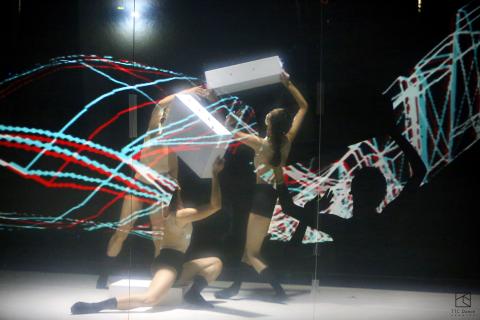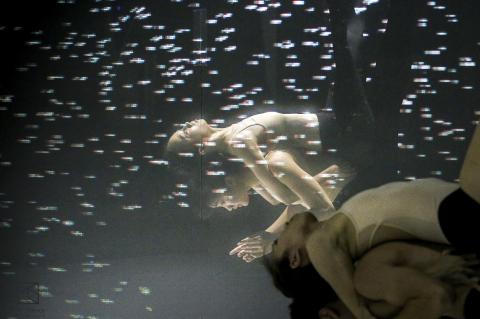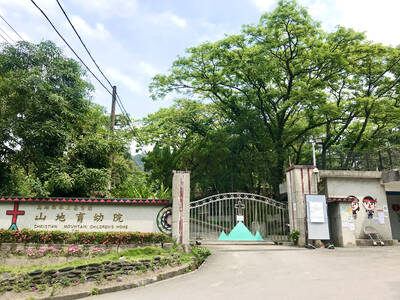Choreographer Chang Ting-ting (張婷婷) is wrapping up her exploration of surrealist imagery, memories and movement this weekend with Cabinet 3: Boundaries of Reality (抽屜三) at the Experimental Theater in the National Theater.
Five years ago this month, inspired by the surrealist paintings of Salvador Dali and his use of clocks, drawers and cabinets to symbolize relations between women and men, Chang created the first part of what has become a trilogy, Cabinet Anthropomorphique (肢‧色:系列-抽屜人), following it up with Persistence of Memory (時空抽屜), which explored movement and imagery, two years ago.
Both were powerful and visually exciting works.

Photo Courtesy of T.T.C. Dance
Chang and her team have spent the past two weeks rehearsing their latest production at Huashan 1914 Creative Park (華山1914), nailing down the technical part of the program.
In a telephone interview on Sunday, she said there was still a lot to do, but she was feeling confident about the show, even though she was still waiting to get the last 10 minutes of music.
Chang said she used the same creative brain trust who worked on part two of the trilogy: musician Lee Shih-yang (李世揚) for the score, stage designer Chen Wei-kuang (陳威光), France-based multimedia artist Lin Jin-yao (林經堯) and lighting designer Goh Boon Ann (吳文安).

Photo Courtesy of T.T.C. Dance
However, Lee has been so busy recently that he was concerned about being able to provide enough music for this show, so he drafted electronica artist Lin Yu-te (林育德) to help with the score.
Persistence of Memory had amazing 3D visuals, but Chang said a lot of people did not want to wear the paper 3D glasses, especially male audience members.
That led to questions about why she wanted to work in 3D in the first place, questions about whether audiences would get so caught up with the images that they would forget the dancers.
Chang said we live in a time of virtual auditory (VA) environments and virtual reality (VR) games, and that has made her interested in how this impacts dance and dance performances.
“I am trying to connect technology and dance,” she said, noting that several other Taiwanese choreographers have also been exploring the boundaries between the two, most notably Huang Yi (黃翊).
She said she feels the dance vocabulary has become more emotional and the dancing body more about pure movement, which is one of the reasons she started working on this latest piece with movement, rather than a piece of music.
“You never find a piece of music that is 60 minutes long,” she said.
For Boundaries of Reality Chang has also been working with a team from National Taiwan University’s multimedia lab to use motion capture and heat sensor technology.
Chang said they used four motion capture sensors, three on the heads of dancers and one on top of a cabinet, while for some of the imagery, the team created images from the dancers’ body heat as they move, she said.
“We see shapes, painting with images, we don’t see the real dancers,” she said, drawing a connection between how she has moved from the use of a real cabinet to an imaginary one over the course of the three productions.
Dali’s cabinets were portrayed through the use of boxes and drawers in the first show, became the line of the 3D screen that divided the audience from the performers in the second and now it is the VR platform for part three.
She said exploring the imaginary world between reality and fiction is also part of the creative process of developing movement.
“When all we see is a dot in space, there is no motion, but when there are two dots, there are hundreds of possibilities, and when there are two people, they create a story, and the possibility of so many stories,” she said.
“I hope you will see this in the dance,” she said.

May 18 to May 24 Pastor Yang Hsu’s (楊煦) congregation was shocked upon seeing the land he chose to build his orphanage. It was surrounded by mountains on three sides, and the only way to access it was to cross a river by foot. The soil was poor due to runoff, and large rocks strewn across the plot prevented much from growing. In addition, there was no running water or electricity. But it was all Yang could afford. He and his Indigenous Atayal wife Lin Feng-ying (林鳳英) had already been caring for 24 orphans in their home, and they were in

On May 2, Chinese Nationalist Party (KMT) Chairman Eric Chu (朱立倫), at a meeting in support of Taipei city councilors at party headquarters, compared President William Lai (賴清德) to Hitler. Chu claimed that unlike any other democracy worldwide in history, no other leader was rooting out opposing parties like Lai and the Democratic Progressive Party (DPP). That his statements are wildly inaccurate was not the point. It was a rallying cry, not a history lesson. This was intentional to provoke the international diplomatic community into a response, which was promptly provided. Both the German and Israeli offices issued statements on Facebook

President William Lai (賴清德) yesterday delivered an address marking the first anniversary of his presidency. In the speech, Lai affirmed Taiwan’s global role in technology, trade and security. He announced economic and national security initiatives, and emphasized democratic values and cross-party cooperation. The following is the full text of his speech: Yesterday, outside of Beida Elementary School in New Taipei City’s Sanxia District (三峽), there was a major traffic accident that, sadly, claimed several lives and resulted in multiple injuries. The Executive Yuan immediately formed a task force, and last night I personally visited the victims in hospital. Central government agencies and the

Australia’s ABC last week published a piece on the recall campaign. The article emphasized the divisions in Taiwanese society and blamed the recall for worsening them. It quotes a supporter of the Taiwan People’s Party (TPP) as saying “I’m 43 years old, born and raised here, and I’ve never seen the country this divided in my entire life.” Apparently, as an adult, she slept through the post-election violence in 2000 and 2004 by the Chinese Nationalist Party (KMT), the veiled coup threats by the military when Chen Shui-bian (陳水扁) became president, the 2006 Red Shirt protests against him ginned up by